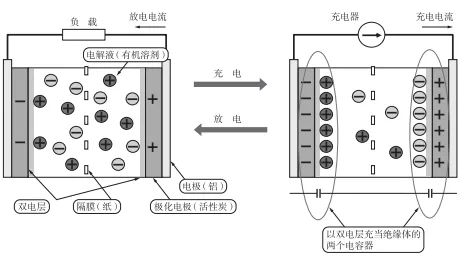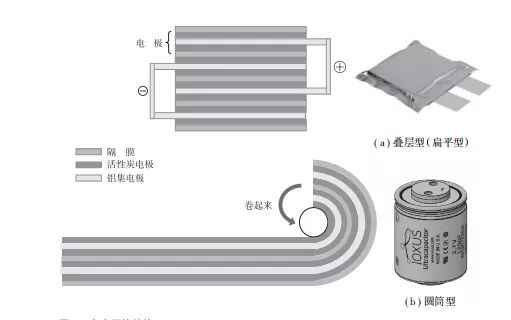Consulting phone:
135-3037-2041
(Mr.Wang)
Electric double layer capacitors (EDLCs) are physical batteries that differ from lithium-ion batteries in structure and working principle.
The electric double layer principle immerses
the electric conductor in the electrolyte, and an insulating layer is formed between the electric conductor and the electrolyte. This insulating layer is naturally occurring, and when a voltage is applied to it, positive and negative charges line up on both sides of the insulating layer, forming a capacitor. Since the interior of the insulating layer is divided into two layers, it is called an electric double layer. The electric double layer will be generated on the positive and negative electrodes at the same time. The capacitor manufactured by the principle of the interface electric double layer is called an electric double layer capacitor, as shown in Figure 1.

figure 1
Electrodes are in series structure
In an electric double layer capacitor, whether it is positive or negative, it is a capacitor. However, the two poles are in a series configuration on the circuit, the reason is that the electrodes cannot get the charge directly from the electrolyte. According to the principle of parallel plate capacitors, the capacitance is proportional to the plate area and inversely proportional to the thickness of the insulator. C = εS/d (1) In the formula, ε is the dielectric constant; d is the thickness of the insulator; S is the plate area.
Basic Structure - Design of Increased Capacitance
The electric double layer insulating film is too thin to be manufactured artificially, and the electric double layer insulating film cannot be made thinner artificially. Therefore, the capacitance can only be increased by increasing the plate area.
(1) Use of activated carbon with large surface area to make polarized electrodes
Activated carbon has a very large specific surface area per unit weight and can be used to make electrode plates (also used as deodorants). The representative raw material of activated carbon is coconut shell. Activated carbon can be produced by incinerating coconut shells and activating them. Activated carbon has an incredible surface area of 2000m2 per gram on average, making it an ideal raw material for realizing large capacity of electric double layer capacitors. As the electrolyte, an organic solution such as PC (propylene carbonate) or ACN (acetonitrile) is used because it has higher pressure resistance than water-soluble electrolytes.
(2)
Different from the insulator of the capacitor, the diaphragm film that plays the role of preventing short circuit only plays the role of preventing the short circuit of the positive and negative activated carbon plates, mainly to prevent the activated carbon particles from freely moving to the opposite plate to form a short circuit, but it can make the electrolysis The ions in the liquid pass through smoothly. Separator materials are mostly cellulose insoluble in electrolyte, non-woven fabrics, and sometimes paper. The materials for making capacitors are only aluminum, activated carbon, paper, and electrolyte, and no rare metals are needed. Therefore, it is less affected by the shortage of raw materials and price monopoly, and is more environmentally friendly.
Structure of Commercialized Electric Double Layer Capacitors
Appearance can be divided into two
Electric double layer capacitors can be divided into multilayer and cylindrical types in terms of appearance. The diaphragm is sandwiched between two layers of aluminum foil coated with activated carbon, and it is rolled into a cylinder and packed into a cylindrical shell, which is called a cylinder type. The electrode-diaphragm-electrode is laminated, which is called a laminated type (or flat type).
Positive and negative electrodes with the same structure
Different from the lithium-ion battery, the structure of the positive and negative electrodes of the electric double-layer capacitor is the same, as shown in Figure 2. The advantage of the stacked type is that the lead wires can be drawn from the electrodes of each layer to the external pins of the capacitor, and the resistance of the collector part is small. The barrel type can also increase the number of wires connected to the aluminum terminals to reduce resistance, but this increases the capacitor diameter, depending on the capacitor size and design philosophy.

figure 2
Release of internal high pressure gas
Electric double-layer capacitors are physical batteries that do not undergo chemical reactions, but when used in high-temperature and high-pressure environments, the impurities remaining in the capacitors will react with the electrolyte to generate gases (CO, CO2, etc.). In the case of continuous use in an overvoltage or high temperature environment exceeding the specification, the amount of gas generated inside increases, which may cause the casing to rupture. Therefore, each battery must have an explosion-proof structure. Of course, the internal organic electrolyte will not burn to cause an explosion like a lithium-ion battery, and the danger is low. Cylindrical capacitors can withstand internal pressures up to 10 atmospheres, and laminated types can only withstand 2 to 3 atmospheres. Therefore, the laminated type uses an exhaust valve, which discharges the gas when the internal gas pressure exceeds a certain value, and automatically closes when the internal pressure drops, keeping the internal air pressure higher than the external air pressure. Due to this mechanism, cracks do not occur even with prolonged use. Cylindrical type mostly adopts explosion-proof valve. When the internal pressure is higher than a certain value, the explosion-proof valve will be opened in various ways. If used beyond the rated value, the explosion-proof valve will open and the capacitor cannot be used at this time. In addition, preventing electrolyte leakage is equally important. In order to avoid the occurrence of the above abnormal situation, the control circuit such as CMS (Capacitor Management System), which will be introduced later, is required to play the role of protection and coordination.